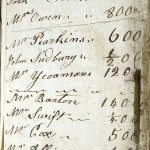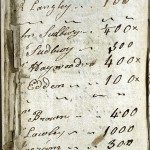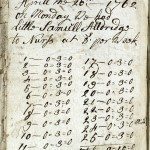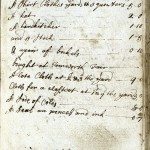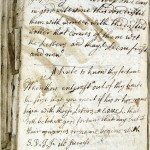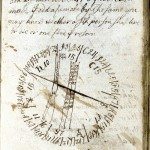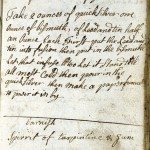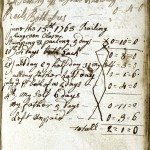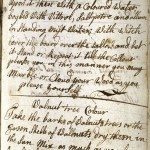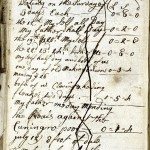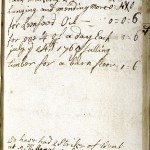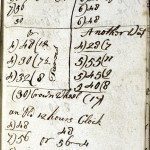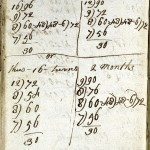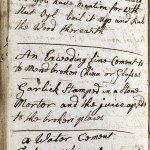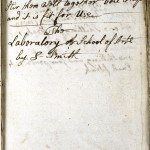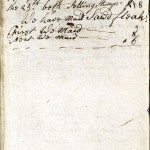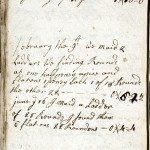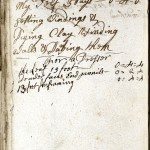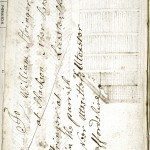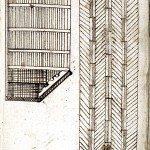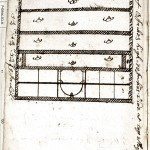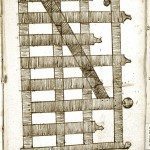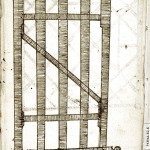The Notebook of Thomas Shakshaft – Part Two
Thomas Shakeshaft
His Book
1751
His pockit book
Thos Thos
Thomas Bamptons Bill
(Entries all crossed out and repeated below)
Thomas Bamptons Bill
October the 19 I was a sawing – £ – s – d
At 14d a day — 0 – 1 – 2
& the 21 — 0 – 1 – 2
& the 22 — 0 – 1 – 2
and the 23 — 0 – 1 – 2
It Comes to — 0 – 4 – 8
The True Sum
Note: This page clearly belongs to the start of the notebook and yet it is found here near the middle. The next page is dated 11 years later. It is further evidence that the 1946 rebinding did not keep the pages in the correct order.
Thos bampton
The 14th of May 1762
My father and me Raling & Stomping 3 day
4 day more
Aprill the 26th 1762
On Monday We had
Little Samull Aldridge
To Nurss at 3s per week
1 – 0 = 3 = 0 —— 17 – 0 = 3 = 0
2 – 0 = 3 = 0 —— 18 – 0 = 3 = 0
3 – 0 = 3 = 0 —— 19 – 0 = 3 = 0
4 – 0 = 3 = 0 —— 20 – 0 = 3 = 0
5 – 0 = 3 = 0 —— 21 – 0 = 3 = 0
6 – 0 = 3 = 0 —— 22 – 0 = 3 = 0
7 – 0 = 3 = 0 —— 23 – 0 = 3 = 0
8 – 0 = 3 = 0 —— 24 – 0 = 3 = 0
9 – 0 = 3 = 0 —— 25 – 0 = 3 = 0
10 – 0 = 3 = 0
11 – 0 = 3 = 0 —– total 3 = 15 = 0
12 – 0 = 3 = 0
13 – 0 = 3 = 0
14 – 0 = 3 = 0
15 – 0 = 3 = 0
16 – 0 = 3 = 0
Note: In spite of their skills it seems that from time to time the Shakeshafts had to turn to anything to secure a living. It might be assumed that this was a Middleton Aldridge and not the one in Shenstone
What it Cost me Lately
September the 30 in a 1751
1 bought at Fasley (Fazeley?) Fair — s – d
A Shirt Cloth 3 yards & 3 quouters — 5 – 0
A hat — 2 – 0
A handkitcher — 1 – 10
And 3 stocks — 1 – 5
& a pair of bockels — 0 – 10
bought at Tamworth Fair
A Cote Cloth at 2s & 3d the yard — 9 – 0
Cloth for wastcot 1s& 9d the yard — 5 – 0
A Lode of Coles — 8 – 0
A Seal an pencel and ink — 0 – 7
Note: At this time Thomas was probably three months past his 20th birthday. He was baptised on 30th August 1731 but his birth date is unknown. Other Shakeshaft births recorded 6-weeks prior to baptism so we might guess the age of Thomas on that basis. That this page is near the middle of the book supports the view that the pages were rebound in the wrong order during the 1946 restoration.
There is a very similar entry on page 7
Benjamin Woodshaw
May the 7th, 1762
My father one day and
half mending the barn
Door — 0 = 1 = 6
both of us before Setting
Up the hovell – one day Each — 2 = 0
My Self one day and quarter
making a ladder — 0 = 1 = 3
one day & 2 half days both — 0 = 4 = 0
june ye 4th 1763 a Coffin for
benjamin Woodshaw. — 0 = 7 = 6
August the 23rd 1763 A Coffin ‘
for Joseph Woodshaw — 0 = 5 = 6
february the 7″” 1765 ‘
Oak box — 0 = 9 = 0
Work done by Benjamin Woodshaw
Coles = 12 hundred at 7 per hun — 0 = 7 = 0
& load of kids Left unpaid
the Carrage — 0 = 4 = 0
Load of Coals — 0 =12 = 0
Note: Was this a bill for work done for the Woodshaws, who then suffered bereavement before payment had been made while the Shakeshafts also owed them money for supplying coal etc? The coffin was probably not actually for Benjamin Woodshaw as he is recorded as supplying further coal to Shakeshafts in January, 1764. Possibly there was a father and son both named Benjamin. The coffin supplied for Joseph Woodshaw was probably smaller for a child as it costs less than the other coffin.
October the 30 – 1751
I Come to James Colins on Wend
I bought a 3 peny Loaf — 0 – 0 – 3
I workt 3 days
I was 3 day the next week
& he found me with Vittels
my father receved 3s & I had 2s- 6d
Wee was 5 days the next week
I finished a pair of bedstids & made
another pair and setting up mangers
at the Swan my father receved 2s
and 4s and 1 had 2s of my father
I went on Wensday January the 29th
workt 3 days & _ father receved 4s & 2s
1 receved 1s at Litchfield fair
& 1 Shilling the 26 of February
Mrs. Barker’s 1762
May ye 4th My father
one day and half — 0 = 1 = 6
it was making Gates
2 peneyworth of Nails — 0 = 0 = 2
Note: The dates on this page seem to be very odd with the 1762 lower part being written eleven years after the upper part
To renew old worn letters
take of the best Galls (oak apples) beat
them grosly and lay them to steep one day
in good wite wine this don distil
them with wine & with the distild watter that comes of them wet
the Letters and thay’l seem fresh and new
A Rule to know thy fortune
When thou enterest out of thy house
the first that you meet if his or her name
begin with these Leters A,E,O,V,C,L that
doth betoken good fortune that day but if
their names or name begins with
S, D, T, J ill success
To know if a woman be with Child
of a boy or a girl take the Letters of
the proper names of its father & mother
add 25 then devide by 47 & if even tis a
male if odd a female by The same you
may know whether a sick person shall
live or die or one fled is return
A way to take fish
Get nettles and house leek, bruise `em
and take the juice and put in a pond so
the fish will gather thither and
if your hands be anointed therewith
you may take `em at pleasure
To Break bands
Take the heart of a mole or wart
Make powder thereof and therewith rub
The bands and they will break
To Lay Gold on Glass
Take chalk and red Lead of Each
alike Grind them together & temper
them with Linseed oyl lay it on
& when it is dry almost dry Lay
Leaf Gold upon it let it dry Then polish it.
What it lies me in
one 3d
—————-
An Agreement made between
my father & me august the 16th
1756 – I must Maintain the house
and receive and pay all and Every
day my father works at the Hall I must
Give him 10 pence and every day he
works at the farmers I must give him
6 pence and he will pay the Rent
out of his wages.
August the
Munday the 16
1756
Note: The last six lines are crossed out which makes reading them very difficult indeed. Even so these lines seem to be part of the document. The rather strange words at the top of the page have something to do with the cost of living as indicated on another page where some similar words do clearly refer to living costs. Thomas had married four weeks earlier on 15th July so presumably adjustments were being made to the housekeeping arrangements to take account of this.
August the 19 – 1756
We ware Both at Mr. Alldridges
20 my father at Mr. Gilberts
21 Both at Mr. Aldridges cost me 3s 3d
To lay Gold on Iron or other Mettels
Take liquid Varnish one pound
Oyl of Linseed & turpintine of each
one ounce mix them Well together
Strike this over any Metal & then
lay on the Gold or Silver & when it is
done polish it.
To Gild Wood or Stone
Bole armoniack oyl of Benjamin
beat & Grind them together with
this Smear the wood or Stone when
it is almost dry lay on the Leaf Gold
let it dry & then polish it
The Eldest Daughter of Thos and
Sarah Shakshaft Born
Friday August 19th
att half an hour past Eight
at Eight in the morning
in the 5th day of the Moon 1757
Chistned September the 21
on St. Matthews day – Mary –
on Wendesday
Note: There is no ‘e’ in the middle of Shakeshaft as written here. Mostly, but not entirely, parish records did not use a middle ‘e’ either at this time. Very few years later Thomas was signing his name with a middle ‘e’ and it became generally used. His grand-daughter used an ‘e’ about 70 years later in a tapestry dated 1826. By the end of the eighteenth century a middle ‘e’ was invariably used in parish records and tombstones and all records spell the name with a middle ‘e’ thereafter. By usage the adoption of a middle ‘e’ became correct. Indeed the spelling became quite exceptionally consistent It was also a reversion to an earlier practice as in the time Thomas’s father, Robert, and also his grandfather John, long before the birth of Thomas, the middle ‘e’ was also generally in use.
To Make a Mehogane Stain
Get the Spirits of Wine and and
dragons blood & red alckany
root & boile them together
red sanders pound em altogether
For a Good black
Get Log Wood boyle it in Crab Urine*
Steel filings Mix them altogether
Let them stand for a Considarble
Wile Coller yor frame 2 or 3
Times then it will com a good
black
Dubble agafortis
Take wood soot old stale & boyl them together Littel aquafort
To Stain Walnut**
Malleber Rub’d on a Cock’s head
keeps another from mouthing
* This seems unlikely
** There is no text under this heading. What is written is a disconnected note which could have been written years later and seemingly has to do with poultry damaging each other. Although the notes written by Thomas were generally logically ordered, illogically placed jottings are also a feature of Thomas’s Notebook.
To Silver Luking Glas
Get quick Silver & tin file
——————
Quick silver in Sides of Globes
Take 2 ounces of quick silver – one
Ounce of bismuth of Lead and tin half
an Ounce Each First put the Lead and
tin into fusion then put in the bismuth
Let that infuse too Let it Stand till
all most Cold then pour in the
quick Silver then make a paper funnel
to power it in by
—————
Varnish
Spirrit of turpintine & gum
Shop Dore 3 foot by 5
Shop Dore 3 by 5
Closcet 5=4 by 2 foot 3
Chamber 3_ by 2 foot 2I[nches]
Street Door 5 foot by 2 – 101[nches]
Shop Door 4f 91[nches] by 2 – 10
Closit Door 5 – 3 by 2 – 3
Chamber 3 – 4 by 2 – 9
Lord Middletons
one day both helping the men in the
Upper plantation to keep a tree out
of the pit ——————– 0 – 2 – 6
both of us Mending ye fleakes
and helping the men 0 – 2 – 6
we put up 2 Rails below the pool
mended the fleaks & Maid
2 Spitting boxes 0*
july 25 1763 both of us Making
a Stile at the hungreen
Close 0 = 2 = 8
There is a note written vertically here which reads:
‘Here
the beetch pd for’
1757 November ye 30 at Robt. Aldridg
December ye 1 falling a tree Cleving
and hewing Crib `feet and bars
my father and me — 0 – 4 – 0
December 5 My father
and me one day Each
mending Cribs — 0 – 2 – 0
The7th 8th 9th Both — 0 – 6 – 0
june ye 12th 1762
Boards for Mrs Owin
popler at 2d per foot for Doors
at hill 55 foot for Doors
and the Ledges — 0 = 9 = 2
26 foot of Square Stuff
at one peney per foot — 0 = 2 = 2
8_ foot popler for Caseing
the Door Caseis — 0 = 1 = 5
Total* — 2 = 19 = 9
Receved — 0 = 10 = 6
Remains Due to me — 2 = 9 = 3
* Clearly this does not add up so Mrs. Owin may have already have owed £2-7-0. Mr. Owin was Overseer of the Poor in 1762 but the Overseer’s accounts prior to 1800 are lost so any connection cannot now be found.
October the 14th 1762
I bought a Pig at —– £ – s – d
Birmingham price — 1 = 4 = 0_
My Charges — 0 = 1 = 0
Bran — 0 = 0 = 3
3 Strik of Acorns of
My Aunt lety* — 0 = 3 = 0
1_ Strik of bran — 0 = 1 = 3
1 Strike of bran — 0 = 0 =10
12 Strike of Acorns of
our Own — 0 =12= 0
Bran — 0 = 0 = 2
2 Strike of peas — 0 = 9 = 0
* Aunt lety is Lettice, the sister of Thomas’s father Robert, who married Joseph Boyce of Birmingham in 1736 (see page 121). She is mentioned elsewhere in the notebook. The name Lettice is used in the next two generations finally becoming Letticia
Note: 1 Strike = 2 Bushells
1 Bushell = 4 Pecks
1 Peck = 2 Gallons (dry measure)
Mr. John Gillbard — december 6 – 1764
My father and me one day Each
mending Cribs — 0 – 2 – 0
My father & me Carraing in
the hungreen Close — 0 – 2 – 0
My father one day making
the Court Gate — 0 – 1 – 0
Both of us Caring Harvest home — 0 – 2 – 0
My self one day at the Cunne
berre barn — 0 – 1 – 0
Both of us 2 days mending
making Cribs — 0 – 4 – 0
Both of us 1 day making Cribs — 0 – 2 – 0
My father one day panting* the
Chamber — 0 – 1 – 0
1765 my father one day
Setting Stomps** & pales — 0 – 1 – 0
Mending the Jack*** against ye Road — 0 – 0 – 6
My Self 1 day & _ taking the
Wood out of the barn End and making
a pitchin hole — 0 – 1 – 3
* Perhaps ‘panting’ should read painting?
** Stomps (or stumps) were vertical posts i.e. gate-stomp = gate-posts and fencepost = fence stomp. More information on page 104
*** A jack was for lifting heavy vehicles (as now) but seemed to be part of the road equipment rather than be carried by a vehicle at John hickmans
Axes = 2 Sawes = Squares= 3
Chisels = Mallit gouge hammers
Gageis = Smoothing planes =
Jack planes = fore planes =
jointers = Moulding planes =
Line Rub-Stones = Gluepot =
November ye 16th 1762
both of us about the Scruto
two days Each — 0 = 4 = 0
Next Week 5 days Each — 0 = 10 = 0
1 day More Each — 0 = 2 = 0
Glew 1 pound, Spriges
200, Oyle 3d , Nails 6d — 0 = 1 = 9
Note: Above is a list of woodworkers’ tools apparently a t the house of John Hickinan It seems to be a list made before visiting Hickman’s premises perhaps as a check that items were found and counted and not overlooked.
What or where is the scruto?
Mr Gilbird — March ye 23
2 days Each
Cleeving Gate Bars & hewing
24 Setting up a Stile & hewing
Rails both of us — 0 = 4 = 0
June the 15th 1763 Railing
hungreen* close
Stumping & pailing 5 days — 0 = 10 = 0
20th 4 days Each — 0 = 8 = 0
28 all day 29 half day 30 My Self — = 3 = 0
All day father half day — 0 = 1 = 6
july ye 1 st both of us 2 days — 0 = 4 = 0
4th My Self 6 days
My father 5 days — 0 = 11 = 0
Left unpaid — 0 = 3 = 6
Totall — 2 = 1 = 0
* Hunts Green
November ye 15th 1762
William booths junear
both of us Setting up Cribs
one day — 0 = 2 = 0
ye 29th both of us Mending
the Chamber floor making
a Stile Setting up posts in
the garden — 0 = 2 = 0
February the 23rd 1764
both of us one day & t/4
Making a Cirb for the Well — = 2 = 6
August ye 11th both of Us
2 days taking a hovel down
and Setting it Up again — 0 = 3 = 9
I was off 3 hours
Note: In this, as in other entries, is to be found evidence of scrupulous honesty. Above Thomas states he was off for three hours so the bill is reduced by 3d. That is 3s 9d and not 4s. Above that is a reference to a quarter day and a charge to reflect that. Taking three hours off might not even be recorded nowadays
Yallow Ink
Mix a little allum to Some Saffron
and Water Another of the Same
the Leaves of yallow cowslips Squeeze
out the juice and mix with allum
Blue Ink
Take elder berries, press the juice
there-of into a Glass and put powdered allum to it add to it about its forth part
of Vinegar and a little Urine then dip
a rag into it and try Whether the
Colour is to your Liking you may if it
is too pale add a Little more of the juice
and if too dark of the vinagar to it.
Ebony Wood Imitateed
Take cleane and Smooth Box boil it in
oil until it turns black ———————– or
Strike your wood over with Spirit of vitriol hold it over a Cole fire and again till it is black anough then polish it or iron filings steeped in beer and urine will make a good black —–
polish with wax
For Staining Wood Black
put 2 ounces of iron filings into a new
earthen pan add to it one ounce of Sal-armoniac dissolved in a quart of vinegar and Let it stand 12 days the Longer the Better then take
Rasped logwood and three ounces of gallnuts pounded fine infuse this in a quail of Lee made
of Lime Let this also Stand the same time as
the above When you have occasion to
use it Warm both these liquors over a
Slow fire and with the Lee first Strike the Wood over you desire to dye and then
with vinegar: repeat this untill you
see the Wood Black enough to your Liking after witch wax and rub it with a wolen
rag and it will Look brite and fine
Bees Wax for all*
To Marble Wood
Whites of eggs beat them and draw where
you will When dry mix quick lime Well
With Wine With a brush or pencil paint
the wood over rub with a linnin rag Smooth
then Varnish
* Does this mean that bees wax should be applied to all the stained wood described on this and the previous page?
To etch Figures upon Wood
Take Melted tallow, Form there-
with flowers or What else you pleas
upon it then a Coloured Water
boyled With Vittrol, Saltpetre and allum
in Standing Mist Water, With Witch
Cover the board over with tallow and let
it Stand or Repeat it till the Collour
pleases you in this manner you may
Marble or Cloud your Wood as you
please your Self
Walnut tree Colour
Take the barks of Walnuts trees or the
green shells of Wallnuts dry them in
the Sun Mix as much as you have
Occasion for with Nut oil, boil it up
And rub the Wood over therewith
A Violet Colour for Wood
Take 4 ounces of brazil, and one
ounce of indigo infuse them together
in a quart of Water and boil your
Wood therein
Glue
Common glue Mix’d up with linseed
oil or varnish Will Stand Water
or isinglass Common Glue soakd in
brandy over night and mixt with a
little fine powder & chalk
Note: The break through of ink from the other side of the page is particularly bad here.
Chuse any number & set it down & the
number of the day under it then take
the number you Shall find under the
first letter of your Christen name add
them all together in one Sum
continues on next page
My Lord Middletons
thursday Aprill ye 8th 1762
My self and father
Wating on the Surveyor –
3 days Each — £0 – 8s – 0d
the 12th My Self all day
My father half day — 0 – 2 – 0
the 19th & 20th My Self — 0 – 2 – 8
the 22d, 23d, 24th both of Us — 0 – 8 – 0
My Self half day and both of us
one day of old Making baicons — 0 – 3 – 4
Monday ye 26
both of us Cleving & hewing
fleakes two days — 0 – 5 – 4
My father one day Mending the Reals against the
Cuningro pool — 0 – 1 – 4
July 12, 8 foot of dale
to make a box for the
Surveyors at 2d per foot — 0 – 1 – 4
half day Making it
& going to tamworth
for hinges — 0 – 0 – 8
Note: The Middleton estate accounts for 7th August, 1762 show Thomas being paid 1s. Od. for two boxes for the surveyor’s maps. The rate of pay here is Is. 4d. per day as it is for all extant entries in the estate accounts. Most estate accounts for this period are lost. Middleton papers that survive are at the University of Nottingham., Mostly there is no mention of the cost of materials for work done anywhere in the notebook -just cost of labour
presumably this follows on from the previous page
19th My self Mending the — — s – d
Watter Lagg by ye plantation — 0 = 8
And 29th Making Up
tow packing boxis for
Wollerton* — 0 = 0 = 8
for Mending beecons
and Staffs for the Surveyors
Sprigs Glue & WorkmariShip
and Shueing them — 0 = 1 = 4
father one quarter of
A day Mending Gates — 0 = 0 = 4
august 7th 10 foot
of dale to Make another
Box for the Surveyors — 0 = 1 = 8
half day Making it — 0 = 0 = 8
august the 22d 1763
both of us Making Up the Little
bridle Gate att Gilbirds pound
and Sawing posts another gate
in the Common one day — 0 = 2 = 8
* The Willugby (otherwise Willoughby) family came to Middleton from Wollaton in Nottingham where they had their principal estate at Wollaton Hall. Although they never left Wollaton their main home for some time in the 18th century seems to have become Middleton Hall before reverting again to Wollaton. Clearly Thomas did not know how to spell Wollaton. Thomas worked a great deal for Lord Middleton at Middleton but no evidence has been found that he ever went to Wollaton and this is the only mention of it to be found in his notebook.
july ye 25th 1763 both of Us
Making a Stile at the — — £ – s – d
hungreen Close — — — 0 = 2 = 8
august ye 22d both of Us
Making up the Little bridle
gate in the pound and
sawing posts for Another
gate in the Corner one day — 0 = 2 = 8
Septr ye 5th both of us Mending the boat Next day
finising the boat & Setting up Some Rails & Stomps at the
top of ye Upper plantation
2 days — 0 = 5 = 4
Sept the 20th both Sawing
4 Orris Rails — 0 = 2 = 8
and half day Sawing
pales — 0 = 1 = 4
— — — 0 =14= 8
Receved the full
Contents of this bill the 5th day
Septr 1763 – – I Say Receved by me
Thos Shakeshaft
Note: This must all be work on Lord Middleton’s estate. It is noticed that Thomas by this time was spelling his name with the middle’e’ and does so here in one of very few signatures we have. He was a few weeks past his 32nd birthday.
Capt. Aldridge
April the 25 – 1764
My Self and father 2 days
Each Making 2 gates and — — £ — s — d
hanging and mending more — 0 = 4 = 0
for Leenseed Oil — 0 = 0 = 6
for one quarter of a day Each — 0 = 0 = 6
july ye 24th 1765 falling
timber for a barn floor — 0 = 1 = 6
we have had 2 Strike of Weat
at 5 Shillings per Strike — 0 =10 = 0
he has Drawd 2 Load
of turf — 0 = 5 = 0
Note: This entry for 1764 is one of the last and suggests that pay rates may have gone back to Is. Od. per day whereas earlier dates in the notebook and the Middleton estate papers consistently give a rate of 1s. 4d. Also Captain Aldridge was in Shenstone so a long journey must have been made to get this work. Maybe times were rather harder in 1764 than they had been a short while earlier
The Desire to Know
How many heads & tails are
There in 30 thrave* of Dogs &
A Cut tail’d bitch
Solution
– 721 heads
– 720 tails
– 1441 total
If 20 dogs for 30 groats go one
Whole year to grass
How many hounds for 60 Pounds** May be Winterd in that place
Solution – – 2400 dogs
* By deduction a thrave must be 24. The term was used for
quantities of thatching materials where one thrave equaled 24 sheaves and one half a thrave equalled one kiver.
* * The word pounds used here is simply guesswork
A piece of Clock Work Shewing
Minits & Seconds – 8 days
the watch part — — — — the Clock part
8) 96 — — 8) 78
8) 60 – 48) 48 – 6) 72 — 6) 48 8 pins
7) 56 — — — — — — 6) 48
30 — — — — — — — 6) 48
Or — — — Another Way
4) 48 (12— — — — 4) 28 (7
4) 30 (7_ — — — — 5) 55 (11
4) 32 (8 — — — — 5) 45 (9
— — — — — — 5) 40 (8
(30)— Crown Wheel — (17)
an Old 12 hours Clock
4) 48 — — — 48
7) 56 — — or — 56-4
6) 54 — — — 54-7
Crown (19) — — — 19-6
Note: Thomas was clearly fascinated by clocks and clock mechanisms. Mavbe this has its roots in the fact that fellow carpenter John Harrison (1693- 1776) was at this time working on his chronometer aiming to win the Board of Longitudes £25,000 prize and in 1763 was awarded the part prize of 5,000. Harrison was made to wait until 1773 when intervention by George III led to the full prize being awarded. Harrison had earlier used wood for cog teeth and this may have encouraged Thomas’s interest.
A piece of 32 days With 16 or 12 turns
the Watch-part
With 16 turns —- – With 12 turns
16) 96 —- —- —- 12) 96
9) 72 —- —- —- 9) 72
8) 60-48) 48-6) 72 —- 8) 60-48) 48-6) 72
7) 56 —- —- —- 7) 56
30 —- —- —- 30
or
thus – 16 – turns —– 2 Months
12) 72 —- — 9) 90
8) 54 —- —- 8) 76
8) 60 — — 8) 60-48) 48-6)
7) 56 —- —- 7) 56
30 —- —- 30
To prepare a black Colour
for Staining Wood
put 2 Ounces of Iron filings into
a new Earthen pan – 1 Ounce of
Sal-armoniac Dissolved in a quart
of Vinegar & Let it Stand 12 days
the Longer the better; then take
Rasped Logwood & 3 Ounces of
Gallnuts pounded fine Infuse this
in a quart of Lee Maid of Lime;
Let this also Stand the same as above
When Usered Warm both those
liquors over a Slow fire and with
the Lee first Strike the Wood over
& then With Vinegar; Repeat
this till the Wood is black Enough
to your Likeing; then Wax it
over & Rub With a Woolen Rag
or
Iron filings Steeped in beer and
Urine Will Make a Good black
Note: Another page (74) is almost identical to this but why it is repeated is not clear. The use or capital letters is particularly random and apparently meaningless.
Walnut tree Colour
Take the bark of Wallnutt
trees or the Green Shells dry
them in the sun Mix as much
as you have occation for
Nut Oyl boil it Up and Rub
the Wood therewith
An Exceeding fine Cement to
to Mend broken China or Glasses
Garlick Stamped in a Stone
Morter and the juice aplide
to the broken places
A Water Cement
Take Mastick, incense, resin, & fine
Cut Cotton of Each alike Melt
& with Some powderd quick-lime
Mix them into a Mass
A Cement as hard as Iron
Melt pitch then take Ground
Sand Worn off from Grindstones
Stir them well together boil it up
and it is fit for Use
The
Laboratory of School of Arts
by G. Smith*
*Note: This book was first published in 1738 and went through several editions during the next 50 years. Copies of a number of the editions including those of 1750 and 1755 which are those most likely to be relevant are at the British Library. Was this a book Thomas owned or had access to? If so, was it a book Thomas used for some of his recipe for wood stains, cements etc?
May the 31st 1763
an Agreement Maid With
Mr Dakin before Mr Brown
For the Use of My Ld Middleton
fleaks, oak heads Sawd, bars Cloven
of one shilling per fleak = 1 = 0
Dito heads Sawd of Oak
and bars Sawd of ash at
one Shilling and four pence = 1 = 4
Each fleak —————-
Note: A fleak is a hurdle or a short element of a fence
july the 26th 1763
We begun to Cleeve fleakes
Cleeving, hewing & sawing 9 Days
half day More
Sept 21 both of Us 2 days Making fleakes
We Maid 8 fleaks Each day that is 16 fleaks
father one day More
both of Us one day More Maid 9 fleaks
both of us one day More Maid 10 fleaks
We Maid 19 fleaks the two days Each
both half day more Sawing heads for fleaks
both 1 day & half Each Sawing heads
we have maid 76 fleaks the
bars Cloven & the heads Sawd all paid
at one Shilling Each
Benjamin Woodshaw
brought us a Load of Coles
in January 1764 price 0 = 10 = 0
february the 9th we maid 2
Ladders We finding Rounds
at one halfpeney apice and
flatons 1 peney Each
1 of 18 Rounds
the other 22 0 = 6 = 2_
june ye 16
I Maid a Ladder
of 28 Rounds I found them
6 flatons 22 Roundons 0 = 4 = 4
Sam,l Hilton
May the 23d 1764
I maid a Grotto
£0 = 5s = 0d
Note: Most of this page has been cut out and we shall never know why. Was it perhaps a bill given to a customer?
“I had of William Booth Jnr 1765
13 foot & _ half Inch Oake board*
At 3d _ per foot______ 0 = 3 = 11_
to Make a box for, Benjamin
Woodshaw
* Note: The half inch refers to the thickness of the wood but no indication is given here of its width. However, this would be unnecessary if the board was a standard width. A board was 9″” wide whereas a plank was 10″” or more wide and 2″” or more thick. A board was 1_ inch thick or thinner such as _ inch in this case.
March the 18th 1765
My father 2 days 0 = 3 = 0
My Self 3 days 0 = 4 = 6
getting Windings &
Diging Clay Winding
Walls & Daubing them
For a Dresser
the Leaf 13 foot 0 = 4 = 4
Drawer faces,
End pannils 0 = 2 = 4
13 foot for framing 0 = 4 = 4
Note: It is not stated who the customer was in this case but reasonably it was almost certainly Lord Middleton. The charge per day here is Is/6d. Two months later the charge to Lord Middleton was back to Is/4d.Every payment made to Thomas Shakeshaft and his father Robert found in the Middleton Estate papers was at the rate of Is/4d per day but much of the estate records is lost Even so it seems odd that the estate papers never show any variation in the rate of payment whereas Thomas does show variations in money received. We do not know for whom the dresser was being made. Possibly Lord Middleton.
Mrs Gilbird 1765
My father one day Setting Setting
Stumps & pales against ye Road* 0 = 1 = 0
Mending the jack 0 = 0 = 6
My Self one day and quarter
taking the Wood out of the
barn End and Making a pitchen**
hole 0 = 1 = 3
july
My Self and father one day Each Mending Gates and Making
a pitchen hole Door 0 = 2 = 0
* In “”Historical & Descriptive Notices of Droylsden”” by John Higson, published 1859, reference is made to road repairing and he quotes ‘ “” the town’s book of a century ago [c1750] reveals the following curious items – viz.—filling, leading & setting up stumps””, then deemed indispensibe in road affairs’. Droysden is now part of Manchester.
In the context of Thomas’s notebook (of about the same date) the phrase “”setting up stumps””, which occurs several times, seems to relate to fencing. Perhaps the two views are not in conflict as fencing may be used to define the edges of roads in some places.
** A pitchen is presumably a pigeon
Lord Middleton
May the 11 – 1765 £ s d
5 days 0 = 6 = 8
16th 9 days 0 = 12 = 0
july 2nd 3 days 0 = 4 = 0
Septr 25th 2 days Mending
the Wood gates 0 = 2 = 8
8 Dozn & half of floats
at 9d the Dozn Comes to 0 = 6 = 4_ 4_ 41/2
Nov the 4th for Cleaning
the Clock & putting a Sucker
on the pump 0 = 2 = 8
December ye 16th half Day
falling a tree for Rails
Next day Loading them &
falling a tree for Stomps
Next day herding & Mortising 0 = 6 = 8
A New buckit for the
Cellor plump 0 = 1 = 4
settled this Account the
31 of December
Note: Payment was made nearly 8 months after the start of this series of jobs which seems an unfairly long time for a working man to have to wait for payment. Perhaps he survived by payments for work done for other customers in this period.
For any Sprain Swelling or
Stretching of Sinews or Nerves
Cummin Seeds 3 ounces boil them
in a point of Oil of Cammomile
yellow bees Wax _ pound let them
boil to the thickness of a Sare-Cloth Spread it on Sheeps Leather Very hot apply it to the place Repeat till
it be Well
For the Scab or itch in Sheep Camelian noir and the herb
bears foot boiled in Water and applied Warm to the places
For the itch and Maggots in Sheep Brimstone & tar Well Stirred together over a slow fire is an Exelent Remedy when the Wool is Sheared off anoint
the sore place. Likewise powder of brimstone Mixt With Wax is
good for the Scab
Nancy Livsey
To William Stringer Maltster
at Shackson* Neer Bosoth
. Licestershire
To
John Stringer at
Nobut in the parrish
of Lee** Neer Utssitter or Utoxeter
. Staffordshire
* Presumably Shackerstone near Market Bosworth
** Now known as Leigh
Note: Nobut is an area to the east of the hamlet of Leigh near Uttoxeter in Staffordshire containing a few farms. There is a Nobut Hall still existing and lived in. Was this the home of the Stringers? It seems possible, perhaps probable, that as the next two pages show designs for furniture, the two Stringers were customers for whom these designs were produced. This view is supported by the book being turned on its side to offer a larger page area. The top of this larger area contains the names and addresses and the lower part the designs for furniture. The quality of Thomas’s extant work is far too high for him to have just been a local village carpenter. He would have attracted customers from a much wider area. Note the breakthrough from the other side of the paper of the bureau.
The side view of a four drawer
Bureau. The front view is on
the next page. The two views
are projected one from the other
by third angle projection.
The left side of the page seems
to be a drawing of the wooden
inlays proposed for use on the
Bureau
Front view and dimensions of the
bureau referred to on the previous
page.
3 foot 3 inches high – 10 inches wide
at the top Slope 13 In
3 foot wide
19 inches backward
front 2 foot 6 In high
drawer depths, 6 _ , 5 _ , 4 _ , 3 _ in
bought of peeter brown
at 2 pence per pound
2 bee hives Weaighing 52 pound
the honey Weaighing 24 pound
the wax Weaighing 2 pound & _
Sold of honey 22 pound £ s d
at 3d _ per pound Coming to 0 = 6 = 5
the Wax sold for 0 = 2 = 7_
0 = 0 = 9_
I gave 0 = 8 = 0
I gain 0 = 1 = 0_
3 pound of honey
we kept besides
Note: The drawing on the other side of the notebook page has shown through. Perhaps the ink was too thin. The transaction described here shows that Thomas had an eye to business
Designs for a Gate
Design for a Hatch.
Design for a Gate.
Note: At 6 feet this is far too high and ornate for a field gate. Possibly the design was for Middleton Hall.
« Previous in this sectionContinue browsing this section


